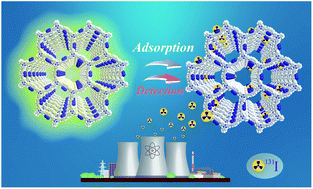Fluorescent conjugated mesoporous polymers with N,N-diethylpropylamine for the efficient capture and real-time detection of volatile iodine†
Abstract
Iodine radioisotopes, one of the major fission products in the nuclear industry, will cause widespread pollution due to their volatility when their inadvertent environmental release occurs. In this paper, a strategy for the efficient capture and real-time detection of iodine by amine-functionalized fluorescent conjugated mesoporous polymers (CMPs) is developed. CMPs are built up through a rigid skeleton and different flexible binding sites for iodine by the Sonogashira–Hagihara coupling reaction. Among them, CMP with N,N-diethylpropylamine (CMPN) shows outstanding capture ability for iodine vapor and dissolved iodine and also exhibits excellent stability against β- or γ-ray irradiation. Moreover, owing to the fluorescence quenching amplification of the conjugation skeleton, a CMPN-coated test paper enables highly sensitive detection of iodine even at 4 °C with a low vapor pressure of 16.8 Pa. To the best of our knowledge, CMPN with flexible and rigid binding sites gives the highest uptake values for iodine among all CMP-based materials reported to date, and it is the first functional material exhibiting the simultaneous adsorption and field detection of iodine vapor.



 Please wait while we load your content...
Please wait while we load your content...